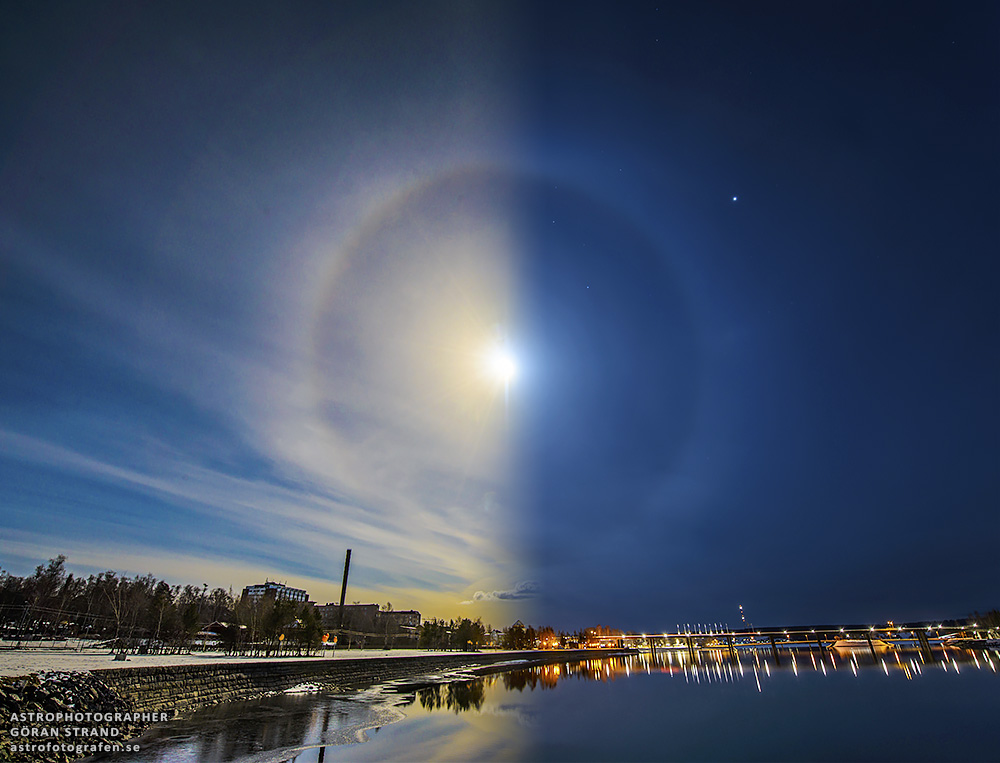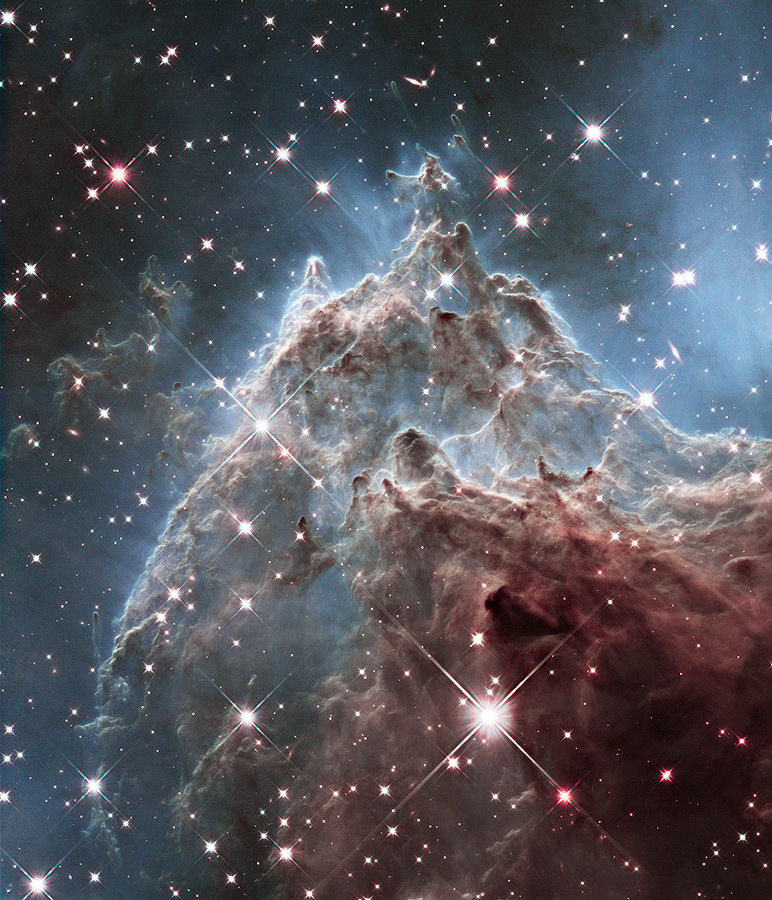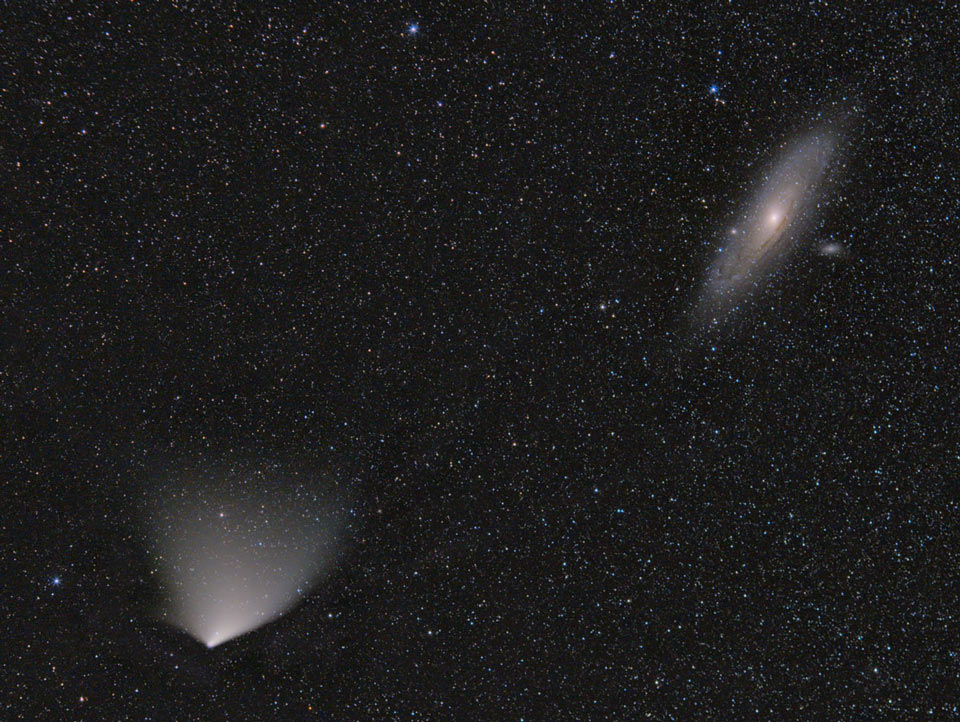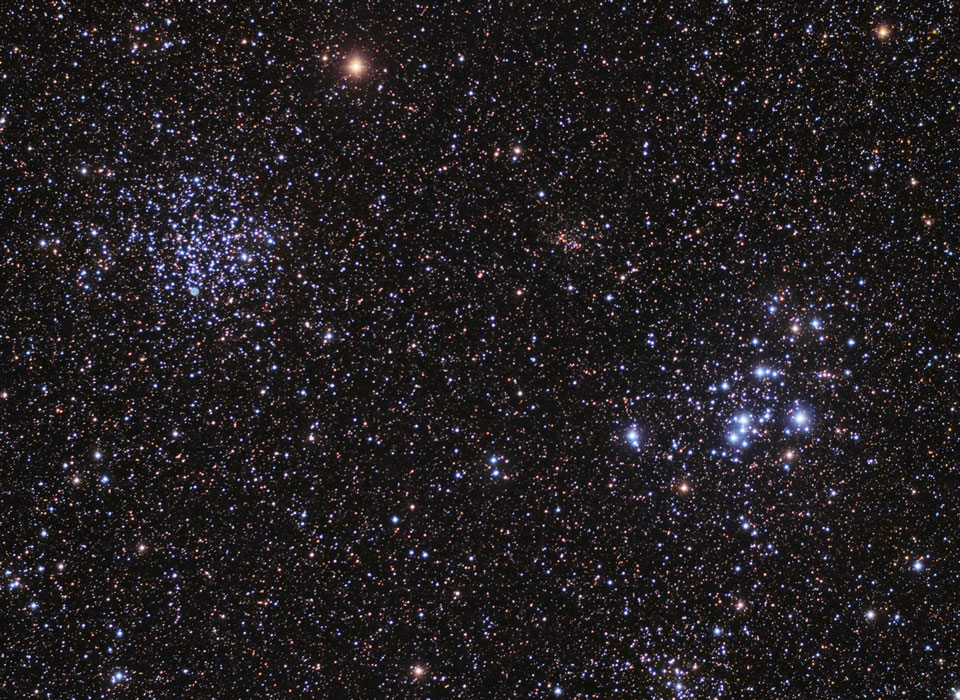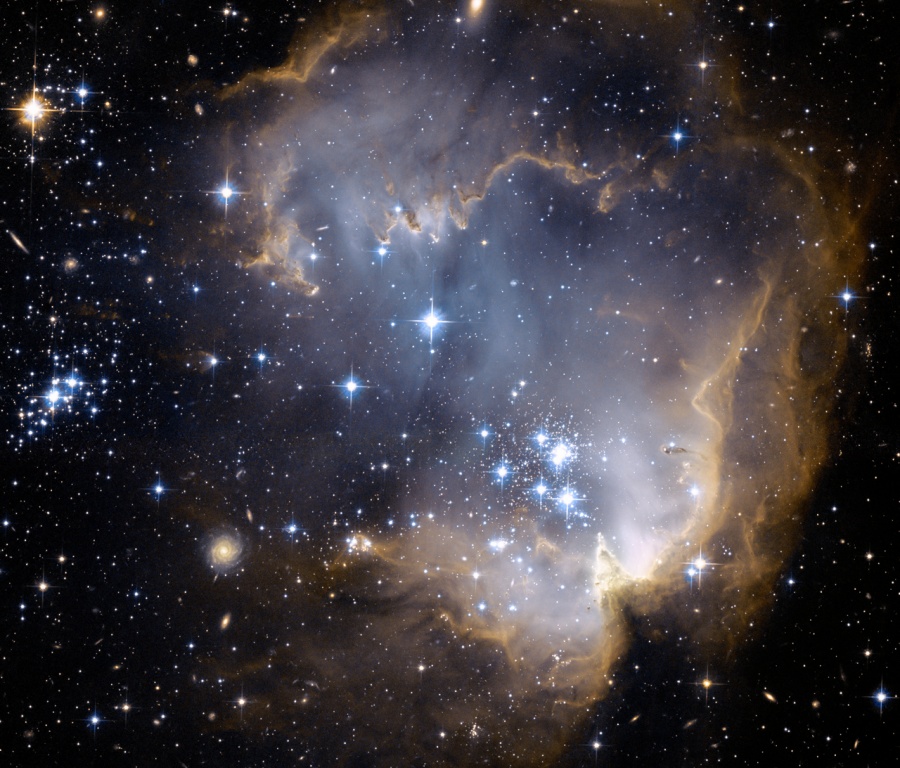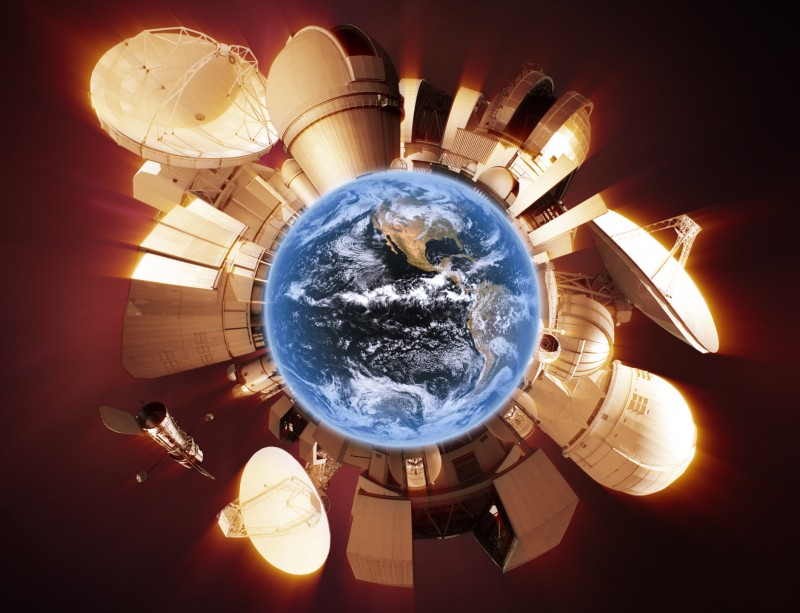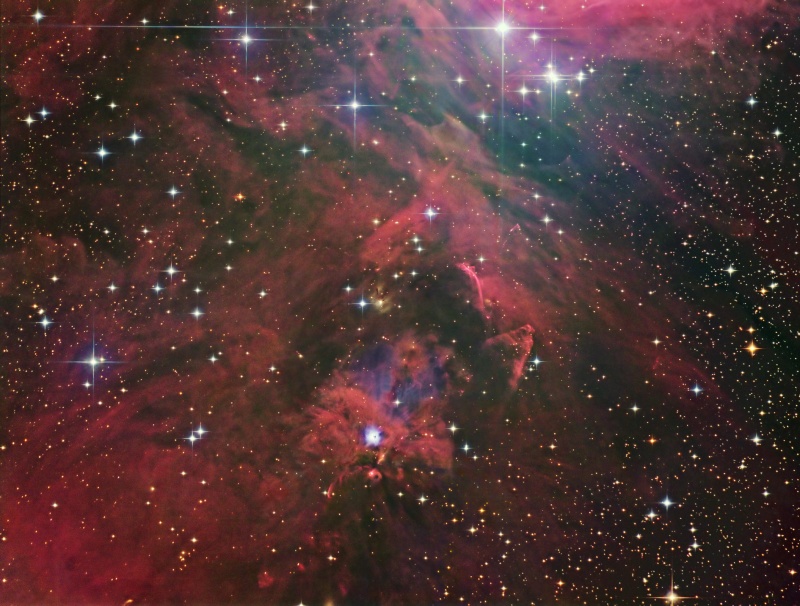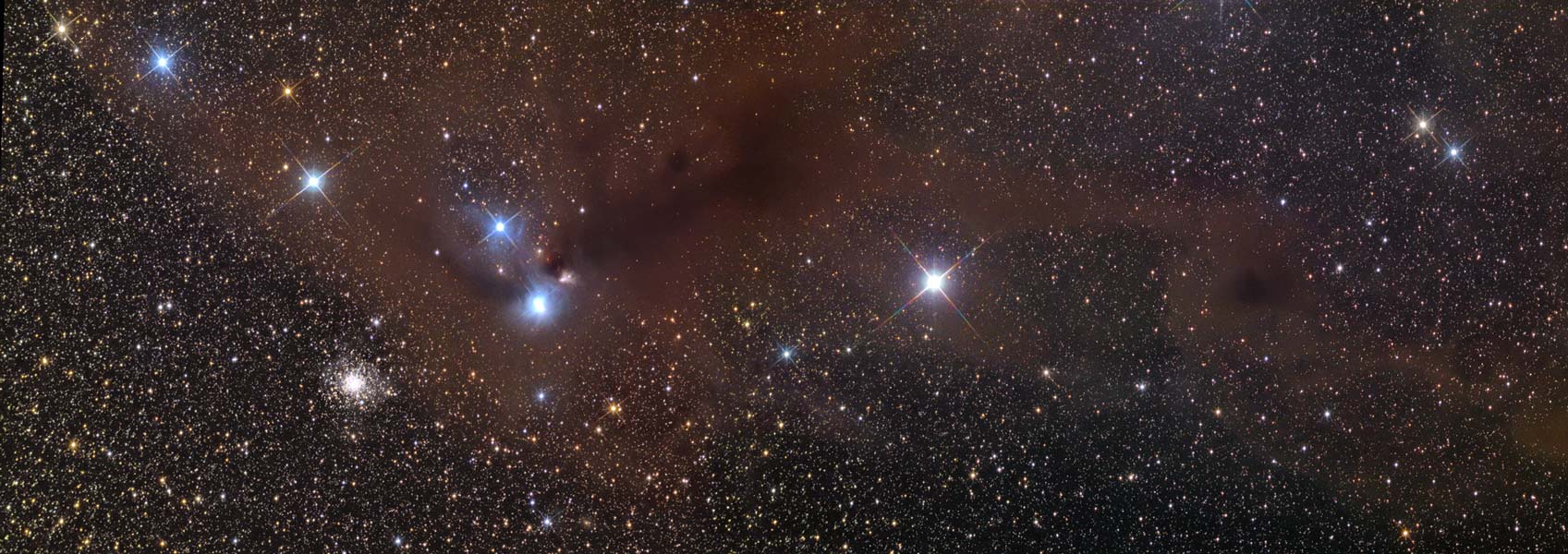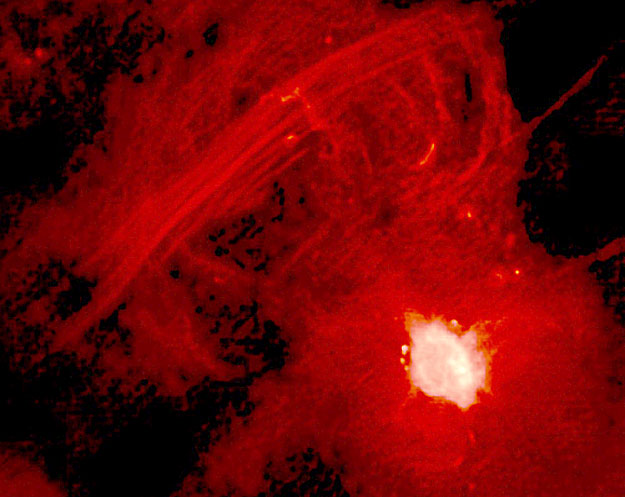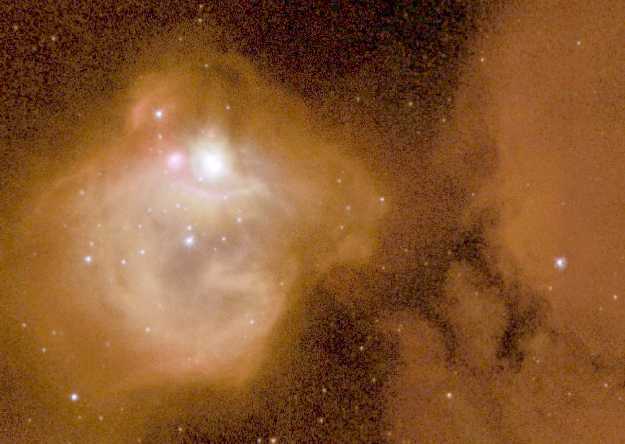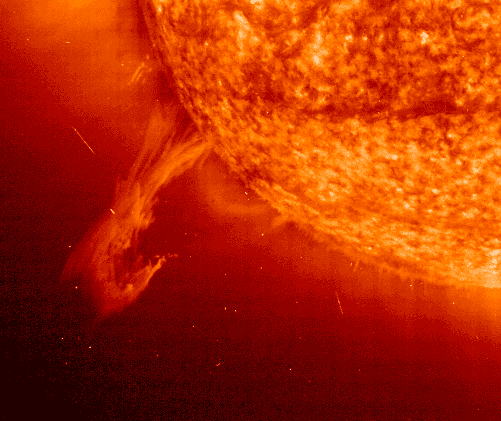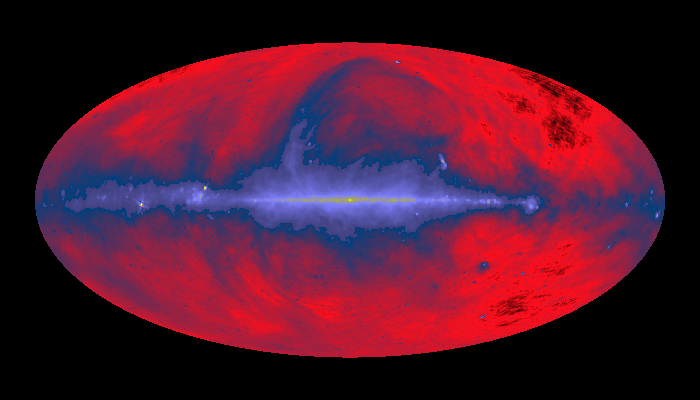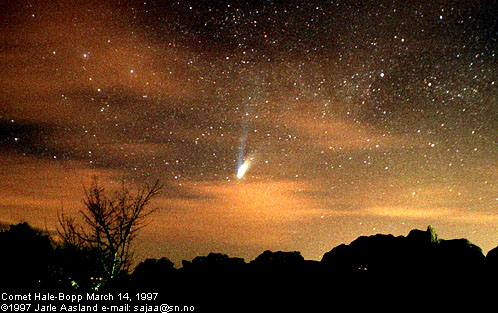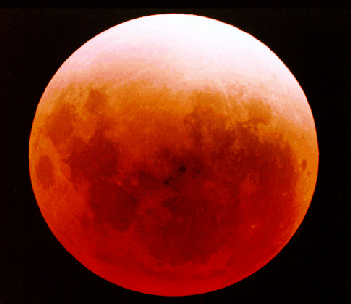| << Previous | Index | Next >> |
2015 Two pictures captured on April 1 are combined in this creative day and night composite. Separated in time by about 10 hours the images otherwise match, looking along the coast at Östersund Sweden. The relative times were chosen to show the Sun and a nearly full Moon at the same place in the cold, early springtime sky. In the night scene Jupiter also shines above the waterfront lights, while Sun and Moon are both surrounded by a beautiful circular ice halo. The Sun and Moon halos really do align, each with an angular radius of 22 degrees. That radius is a constant, not determined by the brightness of Sun or Moon but only by the hexagonal geometry of atmospheric ice crystals and the reflection and refraction of light. Of course tomorrow, April 4, will find the Sun and Moon on opposite sides of planet Earth for a total lunar eclipse.
2014 This fantastic skyscape lies near the edge of NGC 2174 a star forming region about 6,400 light-years away in the nebula-rich constellation of Orion. It follows mountainous clouds of gas and dust carved by winds and radiation from the region's newborn stars, now found scattered in open star clusters embedded around the center of NGC 2174, off the top of the frame. Though star formation continues within these dusty cosmic clouds they will likely be dispersed by the energetic newborn stars within a few million years. Recorded at infrared wavelengths by the Hubble Space Telescope, the interstellar scene spans about 6 light-years. The image celebrates the upcoming 24th anniversary of Hubble's launch onboard the space shuttle orbiter Discovery on April 24, 1990.
2013 Currently, comet PANSTARRS is passing nearly in front of the galaxy Andromeda. Coincidentally, both comet and galaxy appear now to be just about the same angular size. In physical size, even though Comet PANSTARRS is currently the largest object in the Solar System with a tail spanning about 15 times the diameter of the Sun, it is still about 70 billion times smaller than the Andromeda galaxy (M31). The above image was captured on March 30, near Syktyvkar, Russia. As C/2011 L4 (PANSTARRS) on the lower left recedes from the Sun and dims, it is returning to the northerly direction whence it came. When the comet will return is currently unknown, although humans may have merged with computers by then.
2012 Many stars form in clusters. Galactic or open star clusters are relatively young swarms of bright stars born together near the plane of our Milky Way Galaxy. Separated by about a degree on the sky, two nice examples are M46 (upper left) 5,400 light-years in the distance and M47 (lower right) only 1,600 light-years away toward the nautical constellation Puppis. Around 300 million years young M46 contains a few hundred stars in a region about 30 light-years across. Aged 80 million years, M47 is a smaller but looser cluster of about 50 stars spanning 10 light-years. But this portrait of stellar youth also contains an ancient interloper. The small, colorful patch of glowing gas in M46 is actually the planetary nebula NGC 2438 - the final phase in the life of a sun-like star billions of years old. NGC 2438 is estimated to be only 3,000 light-years distant and likely represents a foreground object, only by chance appearing along our line of sight to youthful M46.
2011
2010 Near the outskirts of the Small Magellanic Cloud, a satellite galaxy some 200 thousand light-years distant, lies 5 million year young star cluster NGC 602. Surrounded by natal gas and dust, NGC 602 is featured in this stunning Hubble image of the region. Fantastic ridges and swept back shapes strongly suggest that energetic radiation and shock waves from NGC 602's massive young stars have eroded the dusty material and triggered a progression of star formation moving away from the cluster's center. At the estimated distance of the Small Magellanic Cloud, the picture spans about 200 light-years, but a tantalizing assortment of background galaxies are also visible in the sharp Hubble view. The background galaxies are hundreds of millions of light-years or more beyond NGC 602.
2009 Want to go on an extraordinary voyage? Today you can, by watching Around the World in 80 Telescopes. The 24-hour long webcast is organized by the European Southern Observatory for the International Year of Astronomy cornerstone project 100 Hours of Astronomy. As suggested in this astronomically intense composite, the webcast event follows night and day around the globe to visit some of the most advanced observatories on Earth and in space, exploring the universe in visible light and beyond. The Gemini North Telescope (Hawaii, USA) and the large observatories at the summit of volcanic Mauna Kea are scheduled for the first stops in the program beginning April 3 at 09:00 UT. Others on the schedule include the Swift Satellite and Fermi Gamma-ray Space Telescope, the Himalayan Chandra Telescope (Hanle, India), and the 10-meter South Pole Telescope and IceCube Neutrino Telescope (South Pole, Antarctica).
2008 This tantalizing array of nebulae and stars can be found about 2 degrees south of the famous star-forming Orion Nebula. The region abounds with energetic young stars producing jets and outflows that push through the surrounding material at speeds of hundreds of kilometers per second. The interaction creates luminous shock waves known as Herbig-Haro (HH) objects. For example, the graceful, flowing arc just right of center is cataloged as HH 222, also called the Waterfall Nebula. Seen below the Waterfall, HH 401 has a distinctive cone shape. The bright bluish nebula below and left of center is NGC 1999, a dusty cloud reflecting light from an embedded variable star. The entire cosmic vista spans over 30 light-years, near the edge of the Orion molecular cloud complex some 1,500 light-years distant.
2007 Why would clouds form a hexagon on Saturn? Nobody is yet sure. Originally discovered during the Voyager flybys of Saturn in the 1980s, nobody has ever seen anything like it anywhere else in the Solar System. If Saturn's South Pole wasn't strange enough with its rotating vortex, Saturn's North Pole might now be considered even stranger. The bizarre cloud pattern is shown above in a recent infrared image taken by the Saturn-orbiting Cassini spacecraft. The images show the stability of the hexagon even 20 years after Voyager. Movies of Saturn's North Pole show the cloud structure maintaining its hexagonal structure while rotating. Unlike individual clouds appearing like a hexagon on Earth, the Saturn cloud pattern appears to have six well defined sides of nearly equal length. Four Earths could fit inside the hexagon. Although full explanations are not yet available, planetary scientists are sure to continue to study this most unusual cloud formation for quite some time.
2006 A cosmic dust cloud sprawls across a rich field of stars in this gorgeous wide field telescopic vista looking toward Corona Australis, the Southern Crown. Probably less than 500 light-years away and effectively blocking light from more distant, background stars in the Milky Way, the densest part of the dust cloud is about 8 light-years long. At its tip (lower left) is a series of lovely blue nebulae cataloged as NGC 6726, 6727, 6729, and IC 4812. Their characteristic blue color is produced as light from hot stars is reflected by the cosmic dust. The tiny but intriguing yellowish arc visible near the blue nebulae marks young variable star R Coronae Australis. Magnificent globular star cluster NGC 6723 is seen here below and left of the nebulae. While NGC 6723 appears to be just outside Corona Australis in the constellation Sagittarius, it actually lies nearly 30,000 light-years away, far beyond the Corona Australis dust cloud.
2005 What causes this unusual structure near the center of our Galaxy? The long parallel rays slanting across the top of the above radio image are known collectively as the Galactic Center Radio Arc and jut straight out from the Galactic plane. The Radio Arc is connected to the Galactic center by strange curving filaments known as the Arches. The bright radio structure at the bottom right likely surrounds a black hole at the Galactic center and is known as Sagittarius A*. One origin hypothesis holds that the Radio Arc and the Arches have their geometry because they contain hot plasma flowing along lines of constant magnetic field. Recent images from the Chandra X-ray Observatory appear to show this plasma colliding with a nearby cloud of cold gas.
2004 Gamma rays are the most energetic form of light, packing a million or more times the energy of visible light photons. If you could see gamma rays, the familiar skyscape of steady stars would be replaced by some of the most bizarre objects known to modern astrophysics -- and some which are unknown. When the EGRET instrument on the orbiting Compton Gamma-ray Observatory surveyed the sky in the 1990s, it cataloged 271 celestial sources of high-energy gamma-rays. Researchers identified some with exotic black holes, neutron stars, and distant flaring galaxies. But 170 of the cataloged sources, shown in the above all-sky map, remain unidentified. Many sources in this gamma-ray mystery map likely belong to already known classes of gamma-ray emitters and are simply obscured or too faint to be otherwise positively identified. However, astronomers have called attention to the ribbon of sources winding through the plane of the galaxy, projected here along the middle of the map, which may represent a large unknown class of galactic gamma-ray emitters. In any event, the unidentified sources could remain a mystery until the planned launch of the more sensitive Gamma-ray Large Area Space Telescope in 2007.
2003 If you can find planet Jupiter in tonight's sky, then you can also find M44, popularly known as the Beehive star cluster. In fact, with a pair of binoculars most casual skygazers should find it easy to zero in on this celestial scene. It should be easy because after sunset Jupiter presently rules the night as the brightest "star" overhead. Now near the stationary part of its wandering path through the heavens, Jupiter will obligingly linger for a while at a spot only a degree or so southeast of M44 in the relatively faint constellation Cancer. Seen here in a photograph from March 28, Jupiter (lower left) is strongly overexposed with the stars of M44 swarming above and to the right. The picture approximately corresponds to the view when looking through a typical pair of binoculars. Jupiter is about 30 light-minutes from our fair planet while M44, one of the closest star clusters, is around 600 light-years away.
2002 How much mass do flocculent spirals hide? The above true color image of flocculent spiral galaxy NGC 4414 was taken with the Hubble Space Telescope to help answer this question. Flocculent spirals -- galaxies without well defined spiral arms -- are a quite common form of galaxy, and NGC 4414 is one of the closest. Stars and gas near the visible edge of spiral galaxies orbit the center so fast that the gravity from a large amount of unseen dark matter must be present to hold them together. Pictured above is the photogenic center of NGC 4414. A bright foreground star from our Milky Way Galaxy shines in the foreground of the image. Although NGC 4414's center likely holds little dark matter, understanding its matter distribution helps calibrate the rest of the galaxy and, by deduction, flocculent spirals in general. By determining a precise distance to NGC 4414, astronomers also hope to help calibrate the scale to the more distant universe.
2001 NGC 1748 cannot contain all the new stars it has formed. The young stars, the most massive of which are bright blue, emit so much energy they are pushing out and dispersing the gas and dust that comprise this star forming nebula. Within only the past hundred thousand years, these stars have altered the bubble-like shape of the nebula and will likely destroy the nebula over the next few million years. Of particular interest is a bright region surrounded by a pink ring of dust and gas visible on the left of the above recently released picture by the Hubble Space Telescope. The center of this region is being evacuated by the wind of the brightest star in the nebula. A lane of cooler dust connects NGC 1748 to a larger more diffuse nebula seen on the right. NGC 1748 spans about 25 light-years in diameter and can be found in our galactic neighbor: the Large Magellanic Cloud.
2000 A huge eruptive prominence is seen moving out from our Sun in this condensed half-hour time-lapse sequence. Ten Earths could easily fit in the "claw" of this seemingly solar monster. This large prominence, though, is significant not only for its size, but its shape. The twisted figure eight shape indicates that a complex magnetic field threads through the emerging solar particles. Recent evidence of differential rotation inside the Sun might help account for the surface explosion. The sequence was taken early this year by the Sun-orbiting SOHO satellite. Although large prominences and energetic Coronal Mass Ejections (CMEs) are relatively rare, they are occurring more frequently now that we are near the Solar Maximum, a time of peak sunspot and solar activity in the eleven-year solar cycle.
1999 Tune your radio telescope to 408MHz (408 million cycles per second) and check out the Radio Sky! You should find that frequency on your dial somewhere between US broadcast television channels 13 and 14. In the 1970s large dish antennas at three radio observatories, Jodrell Bank, MPIfR, and Parkes Observatory, were used to do just that - the data were combined to map the entire sky. Near this frequency, cosmic radio waves are generated by high energy electrons spiraling along magnetic fields. In the resulting false color image, the galactic plane runs horizontally through the center, but no stars are visible. Instead, many of the bright sources near the plane are distant pulsars, star forming regions, and supernova remnants, while the grand looping structures are pieces of bubbles blown by local stellar activity. External galaxies like Centaurus A, located above the plane to the right of center, and the LMC (below and right) also shine in the Radio Sky.
1998 This Hubble Space Telescope picture shows Hen-1357, the youngest known planetary nebula. Graceful, gentle curves and symmetry suggest its popular name - The Stingray Nebula. Observations in the 1970s detected no nebular material, but this image from March 1996 clearly shows the Stingray's emerging bubbles and rings of shocked and ionized gas. The gas is energized by the hot central star as it nears the end of its life, evolving toward a final white dwarf phase. The image also shows a companion star (at about 10 o'clock) within the nebula. Astronomers suspect that such companions account for the complex shapes and rings of this and many other planetary nebulae. This cosmic infant is about 130 times the size of our own solar system and growing. It is 18,000 light-years distant, in the southern constellation Ara.
1997 Does a comet's dust tail always orbit behind it? Since comets rotate, they shed gas and dust in all directions equally. Small ice and dust particles expelled by the comet, however, are literally pushed around by sunlight. The smaller the particle, the greater the effect. When the comet is headed inward, sunlight slows down small particles so they orbit behind the comet. When the comet is headed back out though, sunlight speeds them up, so small particles orbit in front of the comet. Comet Hale-Bopp itself is too big to have its orbit affected by the momentum of sunlight. Therefore, since Comet Hale-Bopp started back out to the outer Solar System two days ago, we can expect the dramatic dust tail shown above to shift in front in the coming days.
1996 Tonight's full moon would normally washout the spectacle of Comet Hyakutake's lovely tail, even for those far from light polluted skies. Except that tonight comet observers are in luck - the dance of the planets calls for a total lunar eclipse! Lunar eclipses are caused when the Moon passes through the Earth's shadow. Although dimmed, the eclipsed Moon may not appear completely dark. Sunlight scattered into the Earth's shadow after passing around the planet's edge and through its dusty atmosphere can make the Moon take on dramatic shades of red during totality as demonstrated in the above photo of the November 1993 lunar eclipse. Tonight, totality begins at 6:26 p.m. EST and lasts about an hour and a half. Weather permitting, the eclipse will be visible for all those comet and moon watchers lucky enough to be on the Earth's nightside.
| << Previous | Index | Next >> |
